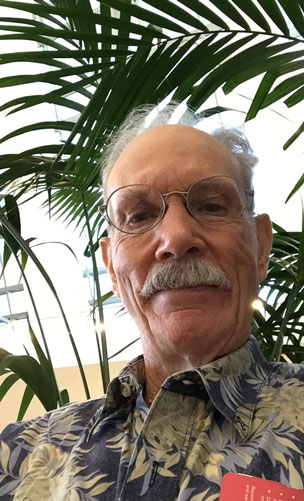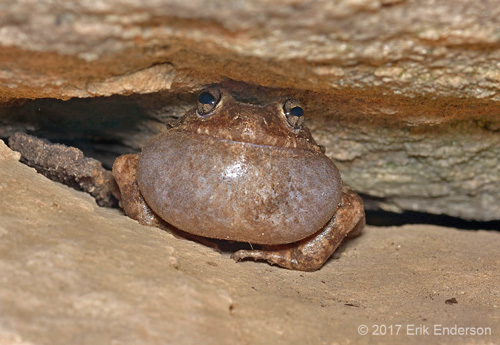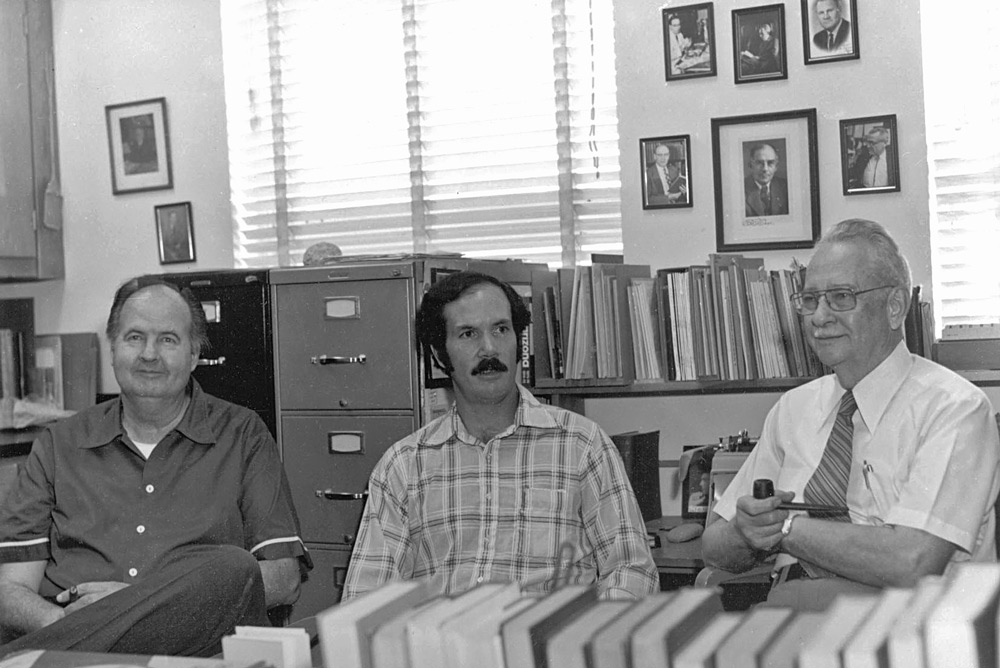Adventures in Loweland
Michael Robinson

Michael Robinson, 2016
Charles H. Lowe was a very special individual, a complex mixture of academic excellence, professional paranoia, periodic unjust and harsh judgments, but loyalty to his team. Life with him was unpredictable, but I learned to value his approach to science, his broad view of the natural history of the Southwest, and as others under his tutelage have done, I learned to weather the storms of his psychosis, and to tolerate his disorganized life and how it affected mine. For me the positives outweighed the negatives.
My first encounters with Chuck Lowe occurred because my undergraduate degree plan required that I enroll in his Ecology course. Many of Lowe’s lectures were attention grabbing, light hearted summaries of ecological principles using Arizona’s natural history as examples, occasionally emphasized by hurtling board erasers to discourage lateral conversations; but other days we endured his mumbling about the views of some ecologist or an ecological theory for which he had low regard, or he was AWOL.
Field trips centered mainly on community ecology as illustrated by the Life Zone concept, and field notebooks were required for admission to the trip. As we ascended the Catalina Mountains, with the spirit of C. Hart Merriam by our side, stops were made at each zone and samples of the dominant plant species were pressed and vertebrates noted. How fortunate we were to have that natural lab in our backyard. Lowe’s herpetology course, was a natural follow up for me as my central interest was zoology, and I had become hooked on the unorthodox Professor and the amphibians and reptiles he and his graduate students studied.
After finishing my BSc., and at the encouragement of Bob Bezy, who had been my graduate teaching assistant in Herpetology, I approached Lowe with the proposition that he be my mentor for a MSc. degree, and he agreed, although he already had a lab full of graduate students. Bezy had suggested I propose a herpetological survey of western Santa Cruz County, an environment inhabited by elusive Barking Frogs (Craugastor augusti) and exotic Vine Snakes (Oxybelus aenus). Lowe quickly nixed that idea and instead outlined research focused on an ecological survey of the high coniferous forest in the Chiricahua Mountains. I can only speculate why he wouldn’t agree with my proposition, but as I would later learn this was a very territorial man, and so off I went into exile on Fly’s Peak to carry out my ecological survey of the high elevation communities. Although herpetologically limited, the project introduced me to Arizona’s ‘Sky Island Mountains, their Madrean biota and its importance in the biogeography of the Southwestern states and northwestern Mexico. All important concepts that have repeatedly served me well.
As a graduate assistant I worked in the lab, mainly as an apprentice to Bezy, learning museum procedures and a lot of Arizona herpetology. Bezy, Jay Cole and Lowe gave me a sound foundation in Southwestern herpetology. By this time I understood that Chuck was a mercurial so and so, and that his magnetic personality strongly attracted or repulsed me and others depending on the day’s polarity. Fortunately for me, many of my lab mates functioned as surrogate academic mentors, and we offered each other psychological assistance during the dark moments.
I can not fail to mention Professor Howard K. Gloyd, a member of my PhD. thesis committee and a friend. As I cleaned skulls in his collection of Southeast Asian vipers, he offered me his philosophy of science and herpetology by sharing his exploits during his tenure at the Chicago Academy of Sciences, and his early days of exploration of Arizona’s herpetology.
The diversity of Lowe’s interests in evolution and adaptation was reflected in the lab’s graduate student research: the evolution and biogeography of Night Lizards (Xantusiidae) (Robert Bezy); physiological ecology of reptiles, birds and mammals (Annette Halpern, lizards; David Hinds, mammals and Eldon Braun birds); ecology and distribution of saguaro cactus (Oscar Soule and Richard Krizman); thermal energy transfer in plant environments (D. Hinds); plant systematics (Richard Felger); the triumvirate of Lowe, J. W. Wright and C.J. Cole quarreling and revealing through chromosome evolution the histories and genesis of the all-female species of Cnemidophorus (now called Aspidoscelis); and the reproductive cycles of desert lizards (S. R. Goldberg). Lab and field experiences between us were frequent, and in their own way each one broadened my education.

Craugaster augusti, Sierra Aconchi, photo by Erik Enderson
Once I accompanied Oscar to southern Sonora in the vicinity of Navojoa, the location of his most southern study population. While measuring the cacti Oscar told me he wanted to learn a few words of Spanish to impress Margarita, the owner of his favorite restaurant and a haunt of the long distance truck drivers. As we worked we practiced a few common salutations, but most of all Oscar wanted to tell Margarita that he was very hungry for her food, so we practiced that several times throughout the day. Upon arriving, we found the restaurant packed with aromatic drivers and food smells. Oscar boldly entered, announcing “tengo mucho hombres” which brought an immediate hush followed by a tremendous uproar, and a blushing Margarita. Something got lost in translation.
My Ph.D. research focused on the evolution and biogeography of the chuckwalla lizards, mainly those inhabiting islands in the Gulf of California and the neighboring mainland. These large herbivores fascinated me, and importantly provided a shelter away from the category 4 storm that had become the intralab and inter-institutional ownership of research on the evolution of the all-female species of whiptail lizards. However, I was once offered a little piece of the action by an invitation to accompany Bob Bezy and Lowe on a trip to coastal southern Baja California and Cerralvo Island. The trip to Cerralvo, more fully recounted by Bezy elsewhere, had several earmarks of a Lowe field trip. Apart from collecting gear, survival and camping equipment was minimal except for water. Unknown to the boatman the menu on our trips always consisted of bread, peanut butter and jelly. Maybe this was a Lowe strategy, as the boatman was so disgusted at our food offerings the next day he went fishing and we lived happily ever after on grilled cabrilla (grouper). Cerralvo has several endemic lizard species (but no Sauromalus) that we were interested in analyzing to better understand the evolution of insular and mainland species. We successfully collected the needed material, which I later analyzed, and somehow the Aspidoscellis lizard god cleared the way for me to publish a paper on the chromosome evolution of the Cerralvo island and mainland species. Apparently that was far enough away from storm central.
On another occassion, Chuck and I and another graduate student that unfortunately my aged brain cannot remember, traveled to the plains region of central Sonora to inventory the toad species responding to a monsoonal “first nighter”. All went well and we returned to our motel in Hermosillo in the last hours of night with many jumping cloth bags. Lowe had us up before breakfast to help him inspect the night’s booty. He was outside our room and as the early risers made their way to breakfast they were greeted by Chuck, in his underwear, cigar in mouth, regally shouting a hearty ‘Buenos Dias sapos for breakfast’, as we scampered about corralling toads that had escaped from our collection bags. Strangely no one passed by our room on their return from breakfast.
While gathering equipment for another field trip, Chuck grabbed me and another Loweian lab rat, as we were sometimes referred to by outsiders, to accompany him to the bank; finances were usually part of the drama of any Lowe trip. Off we sped in a university car, which Lowe often borrowed from the motor pool to use for daily tasks. We marched into the bank and joined the line for him to cash a check. Soon after a very agitated policeman entered the bank and hurried over to Lowe, declaring that he was going to write him tickets for speeding, running a stop sign and a red light. The Chief, standing more than a foot higher than the cop, casually placed his hand on the man’s shoulder and said, “nice job, I’m glad that you’re upholding the law”. Beyond befuddlement, the cop stammered something, turned on his heel and stomped out the door.

Charles Lowe (left), Michael Robinson, and Howard Gloyd, 1968, Gloyd's office, University of Arizona, photo by Oscar Soule
James L. Patton, a student of William Heed, was also an integral part of ‘the lab” Jim and his wife Carol often joined us on field trips to collect pocket mice for his doctoral work on the chromosomal evolution of these small rodents. Jim’s work gave me new perspectives on the importance of large rivers as barriers to gene exchange between these small mammals in northwestern Mexico. Jim and a few others were part of our graduate gang, but had the option of sheltering under their major professor.
My education was further broadened by the courses and field trips I took in my minor subject with Paul S. Martin and Evert Lindsay in the Department of Geochronology. From these men I developed a greater appreciation for the paleoecology and evolution of the Southwestern Arid Region. Martin’s student Tom Van Devender, a herpetologist in his own right, was a frequent visitor to Lowe’s lab as he continued his career contributing to our understanding the region’s Pleistocene biology. Tom and I published a paper on a Miocene lizard fauna from Nebraska and Wyoming, which gave me an understanding of the ancient history of some of Arizona’s contemporary lizards.
I left Arizona in 1975 to take a 3 year research fellowship at the Namib Desert Research Station, followed by a period of research and teaching at Simon Bolivar University in Caracas, Venezuela. In 1985 I returned to Arizona for a short period and went to visit Chuck in the old haunts of our lab. He was in good spirits and holding forth on the state of the world, the U of A and the Department, and of course he recounted several episodes we had shared, including the time I lost it with him and threw my lab keys at him telling him to put ‘em where the sun doesn't shine. He calmly told me I shouldn’t let people bother me so. I stuttered a bit but was unable to reply. I did not see Chuck again because I continued to work outside the United States, but I am grateful for those last memories of a man who was fundamental in guiding my postgraduate education and who taught me how to deal with the unexpected.
Friends occasionally sent me news of his last years and photos of his “memorial service”, which by all accounts was “extraordinary” for a man who was no less, and was in so many ways bigger than life. Today some of us still gather in Tucson, and the Lowe stories reignite, apocryphal or not, as does the camaraderie we once shared during those years.